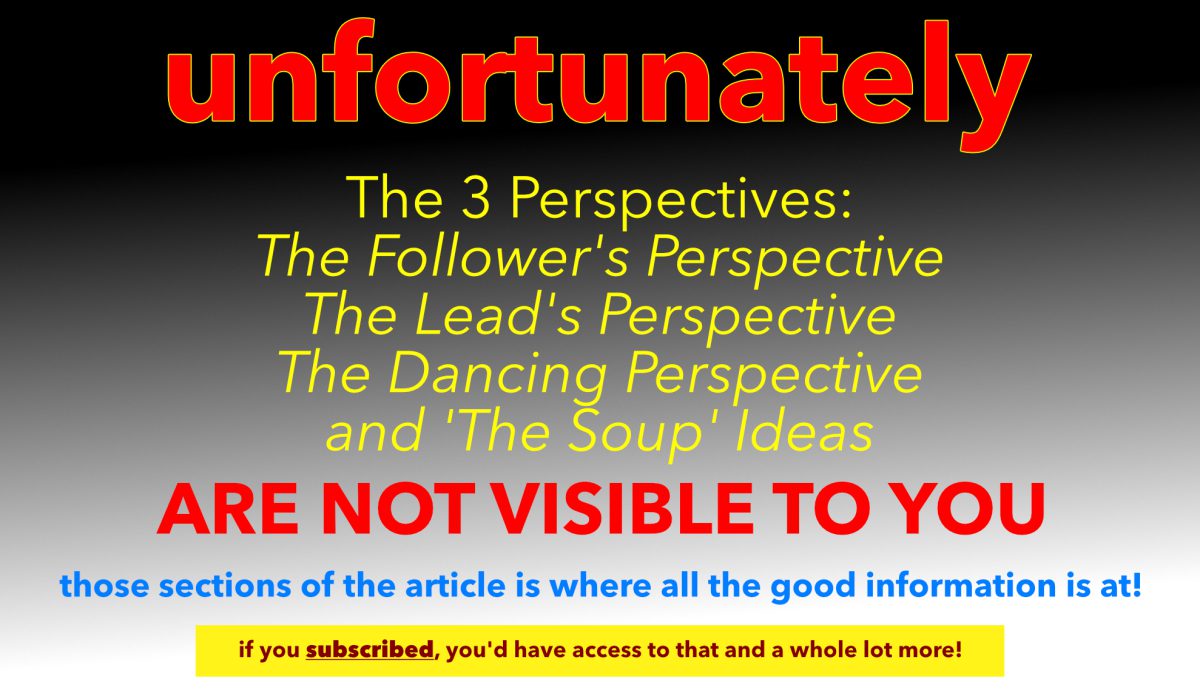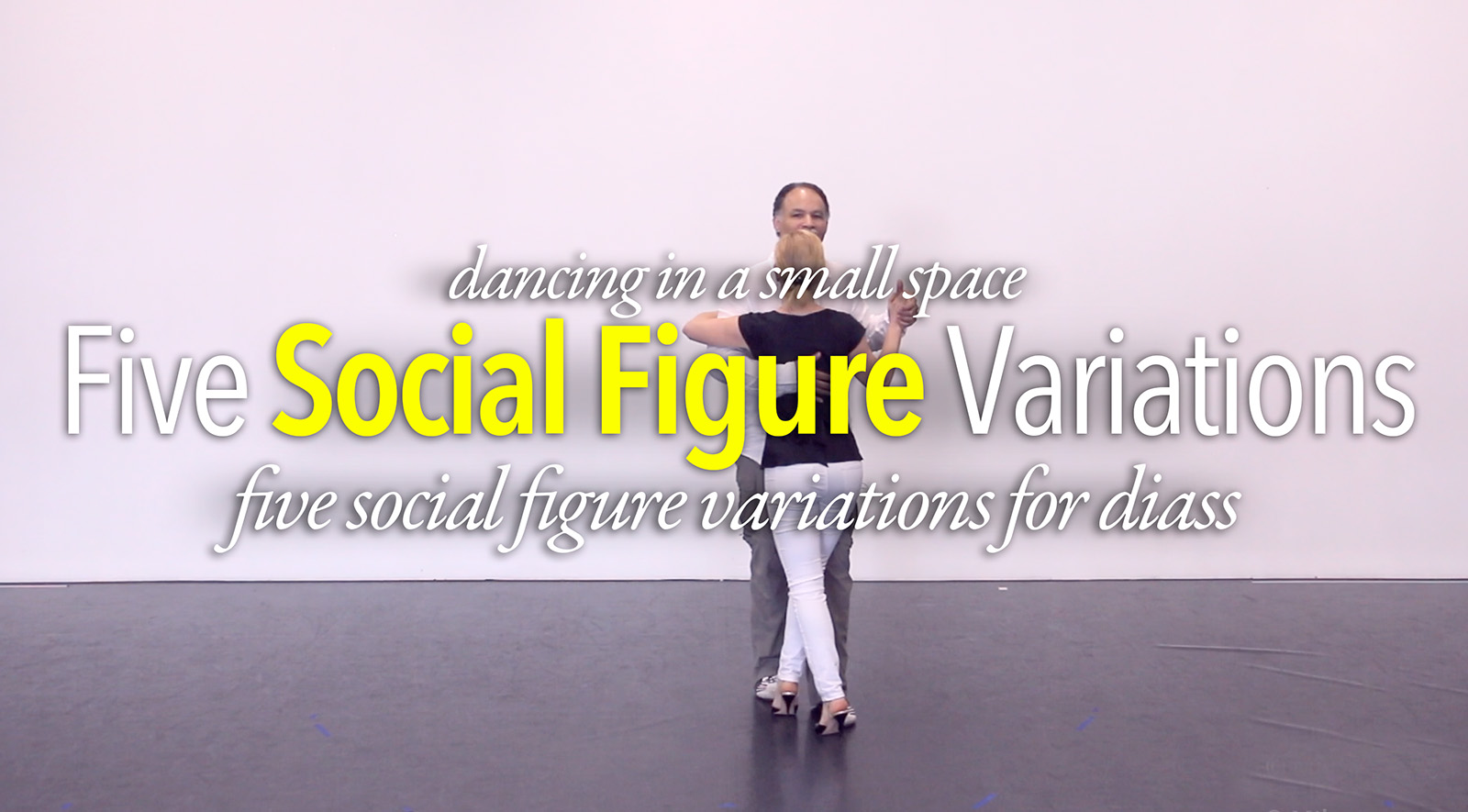Dancing In A Small Space. Typically the idea of dancing within a confined or restricted space is a fearful one for the inexperienced Lead or Follower. Most of that fear exists in either hitting something or someone, or not being able to contain or control what one is doing. So when things in the line of dance get really confined some people get really nervous, and they can’t think outside the box that they’ve put themselves into. The idea of dancing in this environment plays it’s out in a few places, either a crowded local milonga during a special event like a live orchestra, or at a Marathon, an Encuentro (in Europe, not in the United States), or at any Milonga in Buenos Aries. Tango Topics has defined this idea before of what that means and issued two (actually 3, and now 4) videos on the subject of Dancing In A Small Space which we call “DIASS” for short. Today we further the ‘DIASS’ idea a bit by adding a few variations to a theme. The theme being the Five Common Social Figures or the 5 things that we do constantly on at Milonga within the line and lane of dance. Those Five Common Social Figures are as follows:
1.) Walking.
2.) Ochos.
3.) Turns.
4.) Crosses.
5.) Cortados.
To be clear, as there’s a lot of room for interpretation in what those five things actually mean. So let’s clear that up right now:
1.) Walking. Means that we’re engaging only 1 (Parallel System on 2 Tracks) of the 6 Ways of Walking as a foundation of movement.
2.) Ochos. Typically the idea of Ochos engages 2 of the possible 8 types of Ochos > The ‘Lazy’ or Milonguero Ocho or the Traveling Ocho (Forward or Back).
3.) Turns. Turns in Argentine Tango refers to 2 of the possible 8 types of Turns that are commonly used in Argentine Tango. The Follower’s Molinete to the Lead’s Giro, and The Milonguero Turn.
4.) Crosses. Usually when we’re talking about Crosses, we commonly only refer to one type of cross. However, there are in fact multiple variations and several types of Crosses. In this instance we’re only referring to 1 out of 256 types of Argentine Crosses – The common or Normal Cross.
5.) Cortado. In most people’s minds there is only one type of Cortado. However, if you’ve been following this site for some time, you’ll note that’s not the case. In this instance, we’re only referring to the Linear Ocho Cortado from the Closed Side of the Embrace.
These are the Five Social Figures. For more detail on the subject, please go look at the full video in the tangotopics archive.
Using these five figures as a foundation we can create numerous variations on a theme that work with in the line and lane of dance. Those ‘variations on a theme’ are the foundation of this video which are Five Social Figures Variations that we’re exploring today in today’s Tango Topic.
First a reminder of What is “Dancing In A Small Space” (or ‘DIASS’ as Tango Topics refers to this idea) ! There are two parts to the answer to this question:
First, in it’s simplest form, it’s all about the vocabulary and engaging Five pieces of Tango vocabulary. The Five Pieces ? 1.) The 5 of the 6 Ways of Walking. 2.) Milonguero Ochos (sometimes referred to as ‘Lazy’ Ochos)3.) Milonguero Turns (not the Follower’s Molinete). 4.) Back and Forward Crosses (not the Argentine variety, there’s no space!). And 5.) Linear (and Circular) Ocho Cortados. This is all done in Close Embrace. Note that there are no Sacadas, Colgadas, Volcadas, Ganchos, Boloeos, or Death Drops and/or Drags. None. However, there are a whole bunch more pieces of Tango vocabulary that almost never get talked about, or thought of here, that can also be applied, such as Calesitas, Paradas (Step Over), Pasadas (Drags & Sweeps), ’Patter’ (sometimes referred to as ‘Pitter-Patter’), The Incrementals (see Golden Nugget Extensions), just to name a few.
Secondly, there’s the actual ‘Dancing’ part of the statement which is more about movement more than anything else. Said movement is done in a very confined space, no bigger than one meter square, if that. The people that practice this way of dancing, while they may not be conscious of it, there is a sincere desire to not to take up space, mostly because there isn’t any space to begin with. This is moving in milonga environment really, where the distance between couples, on all sides, is no more than about the length of one hand (about 17 centimeters). So from the perspective of the Small Space Dancer, there is precious little space to ‘do’ anything at all due to the conditions of the ronda, so as a result of this confinement, the dancing part is really about the minimal. Everything is done either around the lead, or the space that the couple current occupies and does not extend beyond that space. Quite factually, depending on which city we’re in when dancing this way (Buenos Aires comes to mind), one would take up no more space than the space that one’s feet occupy at that moment in time, and no more than that, but without moving from that spot!


